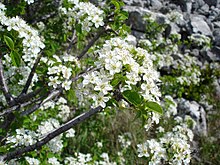| Prunus mahaleb | |
|---|---|

| |
| Spring flowers of St. Lucie cherry | |
| Scientific classification | |
| Kingdom: | Plantae |
| Clade: | Tracheophytes |
| Clade: | Angiosperms |
| Clade: | Eudicots |
| Clade: | Rosids |
| Order: | Rosales |
| Family: | Rosaceae |
| Genus: | Prunus |
| Subgenus: | Prunus subg. Cerasus |
| Species: | P. mahaleb
|
| Binomial name | |
| Prunus mahaleb | |
| Subspecies | |

| |
| Distribution map | |
| Synonyms | |
|
Of the species:[3]
Of subsp. cupaniana:[4]
Of subsp. mahaleb:[5]
| |
Prunus mahaleb, the mahaleb cherry[6] or St Lucie cherry, is a species of cherry tree. The tree is cultivated for a spice obtained from the seeds inside the cherry stones. The seeds have a fragrant smell and have a taste comparable to bitter almonds with cherry notes.
The tree is native to central and southern Europe, Iran and parts of central Asia. It is adjudged to be native in northwestern Europe or at least it is naturalized there.[2][7][8] It is a deciduous tree or large shrub, growing to 2–10 m (rarely up to 12 m) tall with a trunk up to 40 cm diameter.
- ^ Rhodes, L. & Maxted, N. (2016). "Prunus mahaleb". IUCN Red List of Threatened Species. 2016: e.T172121A48416825. Retrieved 24 November 2021.
- ^ a b "Prunus mahaleb". Germplasm Resources Information Network. Agricultural Research Service, United States Department of Agriculture. Retrieved 2008-03-14.
- ^ Cite error: The named reference
POWO_729931-1was invoked but never defined (see the help page). - ^ Cite error: The named reference
POWO_77252155-1was invoked but never defined (see the help page). - ^ Cite error: The named reference
POWO_77231214-1was invoked but never defined (see the help page). - ^ USDA, NRCS (n.d.). "Prunus mahaleb". The PLANTS Database (plants.usda.gov). Greensboro, North Carolina: National Plant Data Team. Retrieved 14 October 2015.
- ^ Euro+Med Plantbase Project: Prunus mahaleb Archived 2007-09-28 at the Wayback Machine
- ^ Rushforth, K. (1999). Trees of Britain and Europe. Collins ISBN 0-00-220013-9.
